General description of the plant
Among the many garden plants, cinquefoil shrub has a rather long flowering period. Under favorable conditions and proper care, it is covered with a scattering of buds from the beginning of summer until the first frost. From the side, the shrub resembles a luxurious fabric that sways gracefully from the summer breeze. Those who raised him on the territory of a country house created for themselves a truly paradise. Looking at the photo of Shrub Potentilla, you can see its unsurpassed originality, original tenderness and sophisticated details.
In its natural environment, in spacious meadows and river valleys, goose cinquefoil is found. Her 80 cm long garlands are richly decorated with bright yellow flowers. Designers use hybrid herbaceous varieties for alpine slides, and a shrub species as a flowering hedge. Due to the fact that the plant grows in nature on pebble, rocky slopes, it successfully takes root on the fertile soil of the summer cottage.
Cinquefoil is a lush, highly branched shrub about 1.5 meters high. Its delicate shoots grow from the root area, forming a dense lace crown in the form of a ball or hemisphere. Most often, the crown width is much greater than the Potentilla height, which gives the plant a unique look throughout the season.
The openwork and curly look gives the bushes original carved leaves, which are divided from 3 to 7 parts. They are a bit like indoor geraniums, cuffs and parsley. Each lobe of the leaf plate has a lanceolate character with a solid frame and a pointed apex. The color is muted greenish with a silvery sheen.
Potentilla shrub buds have a simple shape and reach 3.5 cm in diameter. Consists of 5 rounded petals that surround a fluffy center, consisting of 30 delicate stamens. During flowering, they bloom along the entire shoot, forming openwork garlands against the background of green foliage. It is interesting that throughout this period the buds are interchangeable. Some bear sickle fruits, others are just blooming. Thus, Potentilla can meet even the first snow with young inflorescences.
In addition, the plant is widely used in folk medicine. Many people know the beneficial properties of Potentilla shrub and contraindications. Its raw foliage contains a huge number of useful elements, including:
- vitamin C;
- carotene;
- vitamin C;
- tannins;
- essential oils.
Decoctions from it help to strengthen the immune system, stimulate digestion and have a beneficial effect on blood composition. The only contraindication is the intolerance of its components. A prudent approach to treatment will help you make wise decisions.
Modern breeders continue to work on the creation of new types of Potentilla. Although today many decorative varieties are already known. They differ in size, color of buds and degree of frost resistance. Therefore, gardeners should take these parameters into account when choosing plants for a summer cottage. Consider the most popular varieties of Potentilla shrub, photos and descriptions of plants in order to appreciate their stately beauty.
How cinquefoil is used in medicine and cosmetology
Cinquefoil is called Kuril tea. The leaves and twigs of the plant are brewed like regular tea. In folk medicine, rhizomes are used, which are rich in tannins, saponins, the flavonoid quercetin and resins. The wild varieties of Potentilla have a healing effect: goose, white and erect galangal-grass.Due to the high content of iodine, selenium, zinc and magnesium, their rhizomes are used in the treatment of diseases of the skin, gastrointestinal tract and thyroid gland.
Kuril tea soothes, has an anti-inflammatory effect, strengthens the immune system and normalizes metabolism.
Most of the nutrients accumulate in the plant during flowering. Leaves and branches for infusions are cut during the year, and the rhizomes are dug up in early spring. When taken orally, cinquefoil strengthens hair and nails. The plant extract is added to cosmetic hand and face creams. From the leaves and rhizomes of the decorative Red Ace variety, you can also brew tea and infusions, use them as an additional means to strengthen the body.
Culture care
For unpretentious cinquefoil, the most common care is required, including basic agricultural work.

Frequent and moderate watering, which does not allow stagnant water, is especially important for young seedlings. It is enough to irrigate the soil under them once every 7 days. Adult shrubs are watered less often - as the top layer of the soil dries out. The standard volume is 10 liters of water per bush.
Fertilization is carried out every spring. This requires mineral supplements of potassium and phosphorus. The procedure is carried out before flowering.
The soil under the young bushes is loosened and weeded if it is not mulched. Mulch in the form of peat is preferable because it excludes frequent loosening and prevents the appearance of fungus and harmful insects.
With constant stagnation of moisture at the roots, an overall disease-resistant plant can become sick.
To avoid this, it is important to regularly inspect the shrub and timely carry out preventive spring spraying with insecticidal and fungicidal agents.
Cropping of culture is carried out 1 time in 3 years in spring and autumn. For rejuvenation and for sanitary purposes, the branches are cut to 1/3 of their length.
At the same time, sick, damaged branches should be removed.
Preparation for wintering consists in cleansing the lower part of the trunk from leaves, then it is necessary to remove any plant residues and debris from the roots, and then cover the near-trunk space with peat to a height of 15 cm
A structure is created on top, on which a dense non-woven material or burlap is placed, a reliable shelter is especially important during severe snowless winters
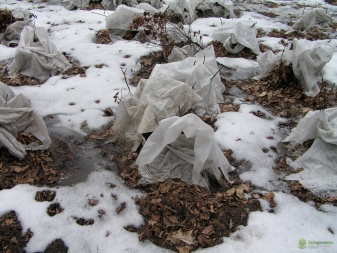

LITTLE SHRUB RED ICE
The flowering period is long and the plant will delight you with its beauty from June to October.
When deciding on a given plant, you must remember that the most suitable soil is moist.
Features of growing Red Ice
- In order for the plant to grow beautiful and to please the eye of its owner, it is necessary to plant it in a place where there is a sufficient amount of shade, since the plant loves shade;
- The soil must be moistened, so the drying out of the plant should not be otherwise it will simply die;
- Grows well in places where the air humidity is high;
- It takes root well on the territory of the city, carries gases and smoke, and therefore it can be planted on the territory of the city.
In order for the shrub to grow beautiful, it is planted at a distance of 60 centimeters from each other.
When planting, you need to pay attention to the mineral content of the soil. If it is not enough, then fertilization is necessary.
Red Ice belongs to the representatives of the third group, for the fact that throughout the summer the plant changes its color. The flowers initially bloom orange-red, then become with a red tint, and as soon as the cold begins on the street, they acquire a bright red color.
Proper plant care
Despite the fact that the plant is not whimsical, it must be looked after. For proper care, you must observe the following points that will help you grow a plant that will delight you for a long time.
- The plant loves cleanliness, so it is necessary to clear away debris around it when using a rake. There should be no old leaves and branches;
- The shape of the plant is spherical, but in order for it to be just like that, it must be cut off. For this, a pruner is used so as not to damage the branches;
- Pruning the plant should be half the maximum of the total length, optimally cut to 1/3 part.
Pros of planting Red Ice
- An unpretentious shrub that does not require special care and does not take up much space;
- can grow in the conditions of Central Russia, the Urals and other regions of the country. Even frost up to minus 30 degrees is not terrible for her;
- The leaves of the plant can be used as a tea infuser, since they contain a large amount of vitamins and microelements. In addition, they are perfect for preparing various medicines at home. The plant has good anti-inflammatory and analgesic properties. Help, if necessary, to restore the functions of the thyroid gland;
- Blooms for a long time - up to 4 months of flowering, due to which Potentilla looks great on garden plots and pleases its owners.
By planting this plant, you will enjoy its beauty.
Pests, diseases and methods of control
Cinquefoil Abbotswood is quite resistant to various diseases and pests, but sometimes it gets sick with rust. This fungal disease is not detrimental to the plant, but at the same time affects the decorative effect of the shrub.
In this case, it can be treated with a soapy copper liquid. Also, do not plant Potentilla near coniferous trees.
Sometimes the plant is invaded by caterpillars. This insect eats the leaves of the bush, and also lays eggs on their back side. As a result, the shrub stops developing fully. To cope with such a problem, it can be treated with Actellik's solution or Acarin.

Types and varieties of shrub Potentilla with a description
There are over 200 types of Potentilla. About 150 species grow in Russia. Perennial varieties are popular among gardeners.
Yellow cinquefoil Goldfinger
The height of the shrub reaches from 1 to 1.5 m. The five-leafed plant has dark green foliage. The flowering period is from early summer to October. Numerous yellow flowers up to 5 cm in diameter appear on the bush.
Pink Cinquefoil Pink Queen
A ground cover plant with a height of 60-80 cm, and can grow up to 1.2 m wide. Numerous flowers of a pale pink color with a yellow center and a diameter of 3 cm appear on the bush. The flowering period of the pink princess lasts from May to November. The dark green foliage is small, feathery and complex. Creeping shoots, red-brown.
Red cinquefoil Red Ice
The creeping stems reach 65 cm in height, the diameter of the plant crown is up to 1.3 m. The foliage has a light green tint. First, red-orange flowers appear in spring, and in summer they turn yellow-orange. Orange Potentilla flowers are up to 3.5 cm in diameter. The flowering period begins in June and ends in October.

Kuril tea varieties Red Ice
Hybrid cinquefoil
A perennial herb with an oblique or vertical root system. The diameter of the flowers is 4 cm, they are collected in corymbose or racemose inflorescences. Erect and branching stems reach 90 cm in height. The five-leaf corolla can be pink, red, dark purple, or yellow. The most popular varieties of hybrid Potentilla are Yellow Queen and Master Floris.
Cinquefoil large-flowered
Small shrub up to 20 cm high with horizontal shoots. The leaves are characterized by a trifoliate structure, dark green with gray. Large-flowered Potentilla begins to bloom in mid-summer. She has beautiful large, single and golden yellow flowers.
Interesting! Outwardly, the Nepalese cinquefoil with berries and leaves looks like strawberries. Plants differ in taste. In addition, Potentilla has yellow flowers.
Transplanting shrub Potentilla after purchase in the open field
It is better to purchase seedlings in a nursery in mid-April and immediately plant them in the ground in a permanent place. The plant should have several shoots and a small crown. It is better not to buy a cinquefoil in the flowering stage, because abrupt changes will lead to the development of diseases and impairment of growth.
The soil for Potentilla should be slightly acidic, fertile, water and air permeable, therefore lime and mineral fertilizers should be periodically added to the soil. It is better to grow in such a substrate - sand, peat and leafy earth in a ratio of 1: 2: 2.

Ornamental plant in a pot
An ornamental shrub is best planted in the ground in mid-spring, when the snow has completely melted. 20 minutes before planting, it is necessary to water the plant with settled water at room temperature. Step by step process:
- Dig a hole with a diameter of 50 cm and a depth of 60 cm (its size should be twice as large as the rhizome of the bush).
- At the bottom of the pit, drainage is laid out from expanded clay or small crushed stone about 15 cm thick.
- The seedling is removed from the container.
- The cinquefoil is lowered into the hole and covered with soil.
- The plant is watered and more soil is added to ground level.
- After half an hour, the five-leafed leaf is watered with liquid top dressing to stimulate growth and mulching is carried out.
Note! When creating a hedge, the distance between rows and bushes should be about 40 cm.To avoid voids, it is recommended to plant in a checkerboard pattern
The tree bush does not tolerate both the scorching sun and the lack of ultraviolet radiation, so it is better to choose partial shade, where the rays will break through in the evening and morning. The cinquefoil prefers an open space, then it will grow and bloom more luxuriantly. The cinquefoil flower is a long-liver, so it is worth considering in advance the neighborhood with other plants.
It is necessary to plant Kuril tea in the evening or in the morning, when the sun's rays do not burn. For this process, seedlings and seeds are suitable, which you can collect yourself. Seed collection is carried out in August or early September. Store them in a cool place.
Interesting! The quinfoil is often used in landscape design. The plant can be combined with barberry, spruce, pine, cotoneaster, lavender, roses, juniper, spirea, fescue, geyher.
Flower reproduction methods
Potentilla variety Red Ice is easily propagated by seed and vegetative methods. In nature, bushes sprout root shoots, the wind carries seeds through the air. Gardeners often propagate cinquefoil by layering and cuttings. The division of the bush is suitable for plants that have lived in one place for more than five years, have grown in width and give small flowers. Seeds need to be germinated in boxes.
Divide the bush
The procedure is carried out in the spring, before the start of sap flow:
- dig up a bush;
- divide the rhizome so that there are 2-3 buds for each part;
- planted in a new place in a pre-prepared planting pit.
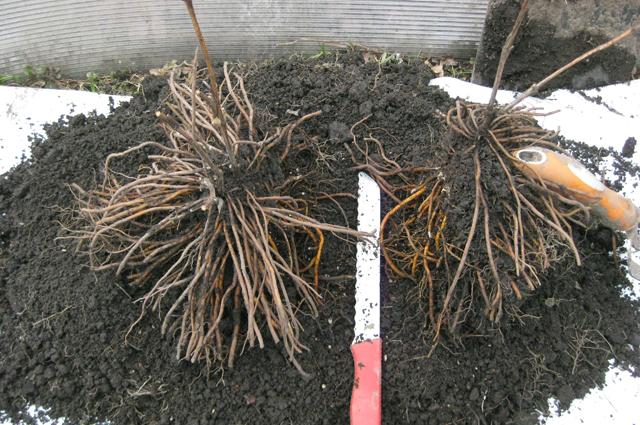
Delenki are blooming this year.
Collecting seeds
A more time-consuming method of reproduction of Potentilla is growing seedlings from seeds:
- the contents of the seed pods are sown in large boxes or flowerpots;
- cover with foil;
- ventilate once a week and, if necessary, moisten the soil;
- in spring, with the appearance of strong shoots with 2-3 leaves, the seedlings are transferred to the garden;
- for the winter, young bushes are covered: they mulch the soil, cover with spunbond.
In the second year, the seedlings are ready to be transplanted to a permanent place in the garden, and in the third year, flowering can be observed.
Potentilla seeds are highly germinating. They can be germinated naturally - sown in the ground in the fall. In winter they will undergo natural stratification, and in spring they will rise. The disadvantage of seed reproduction is that the bushes do not retain varietal characteristics.
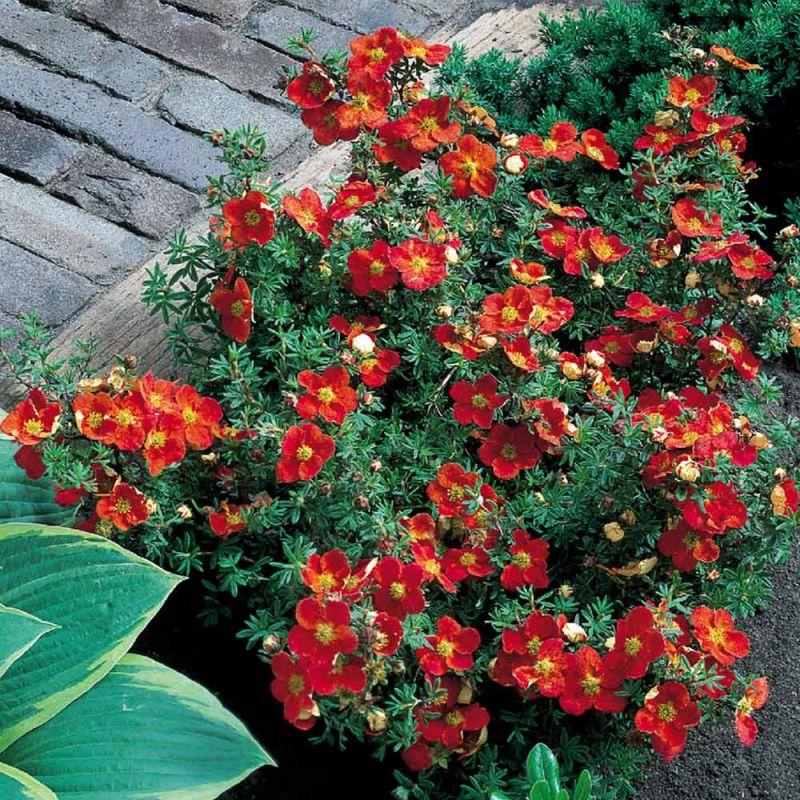
Layers
The method is suitable for propagation of bushes at 2-3 years of age:
- in the spring they choose the lower branch;
- dig a groove under it;
- bend to the ground;
- trimmed from the outside;
- lowered by an incision into the groove and buried.
During the three summer months, the cuttings will take root. By the fall, a separate place is being prepared for him on the site. In September, a new plant is dug up, separated from the main bush and transplanted.
Cuttings
Cuttings are cut in summer and autumn:
- 10 centimeters long tops are cut from shoots with dense bark;
- kept in a solution of a root growth stimulator;
- mix garden soil with peat and sand and fill seedling boxes;
- cuttings are planted.

Seedlings prepared in autumn can be transplanted into separate flowerpots, and planted in the garden in spring. Summer cuttings are rooted in the open field. After the roots appear, they are planted in the ground and covered with plastic or glass jars. With the appearance of the leaves, the banks are removed. Seedlings in boxes and in the garden should be watered and sprayed regularly.
Possible diseases and pests
The plant is unpretentious and in most cases is immune to various diseases. But in bad weather with rains and cold, plantings may be damaged:
- rust. Spots of yellow-brown color appear on the foliage with spores on the inside. Boric acid or potassium permanganate as a root fertilizer will help get rid of the problem. The treatment of Potentilla with solutions of copper sulfate or colloidal sulfur is excellent.
- scoops. Insecticide treatment according to the instructions will eliminate pests from Potentilla.
- spider mites. The presence of parasites is characterized by the appearance of cobwebs, spots on the leaves of brown color. The problem arises during hot and dry summers. You can remove ticks by spraying the plant with a soapy solution with ash.
- spotted. Yellow, gray or red spots form on foliage due to temperature changes, dry air, lack of light or nutrients. Treatment consists of the use of fungicides. Severely infested stems must be eliminated.
Important! The plant should not be planted near pine trees, on which rust spores often remain after wintering. Sometimes caterpillars can be found on the bush, which devour the foliage and lay eggs on the lower leaves.
As a result, it is impossible to grow a well-developed five-leafed leaf, it will begin to dry out gradually. Insecticides will help get rid of pests
Sometimes caterpillars can be found on the bush, which devour the foliage and lay eggs on the lower leaves. As a result, it is impossible to grow a well-developed five-leafed leaf, it will begin to dry out gradually. Insecticides will help get rid of pests.
Kuril tea is a beautiful plant that will decorate a garden, dacha or area near the house with bright flowers. Shrubs are both large and short. The plant is often used for colds in the form of tea, if there are no contraindications. Gardeners, especially beginners, should know when unpretentious white shrub cinquefoil blooms, how to care for it and the rules for planting in the ground.
vote
Article Rating
Breeding methods
Goldstar cinquefoil is propagated on the site in several ways: by seeds, cuttings, dividing the bush, layering.

By dividing
The division procedure is carried out as follows:
- dig up an old bush with a pitchfork;
- divide it into parts in such a way that each division has rhizomes and buds;
- bushes are planted in prepared holes, watered, mulched.
In order for the plants to take root faster, the root system can be treated with root formation stimulants.
Important! The tool for dividing the bush must be sharp and disinfected.

Cuttings
Propagation by cuttings is performed as follows:
- cut shoots 10-12 centimeters long;
- the lower part is dusted with a rooting stimulator;
- cuttings are planted in a shaded area of the site;
- covered with glass jars.
Water the cuttings as needed. They are planted in a permanent place after a year.
Seeds
Seed propagation is rarely used by gardeners, since the method is laborious, and the bushes bloom much longer than those grown in other ways. Seeds are collected for this in the fall, sown at the end of winter, first in a planting box, then the seedlings are transplanted into separate pots. A year later, young plants are planted in open ground.
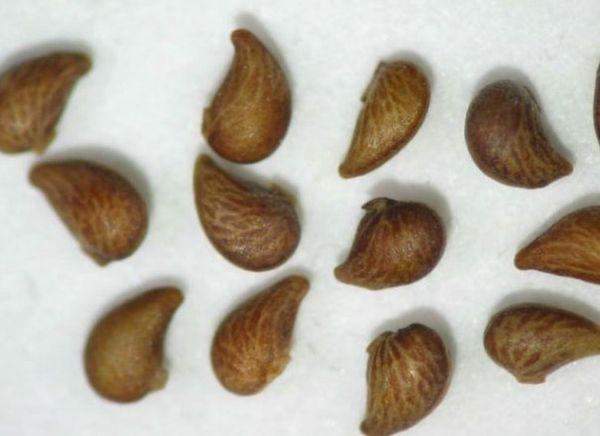
Layers
To propagate cinquefoil by layering, you need to follow these steps:
- the lower shoot is freed from the foliage in the middle part;
- bends to the ground, pinned;
- covered with earth, watered.
During the season, the place of pinning is watered with water. In autumn, the cutting is separated and planted separately. For the winter it needs to be covered with peat and dry leaves.
Care
Despite its unpretentiousness, Kuril tea needs weeding actions, regular watering, top dressing and weed removal.
In hot summer, the soil is moistened 2-3 times a week. The water should be at room temperature.
In addition, red cinquefoil loves to "take a shower" on summer evenings. Dry air is undesirable for this plant.
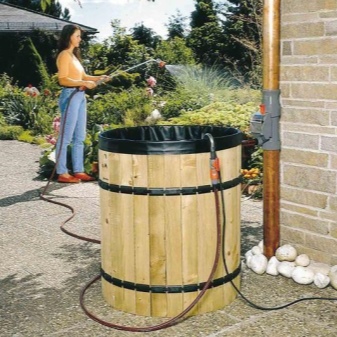

As for feeding, phosphorus and potash fertilizers are suitable for red Potentilla, which are preferably applied in the spring. Kuril tea is cut in late autumn (October-November). This procedure allows you to give the perennial a beautiful aesthetic appearance, and also stimulates abundant flowering.

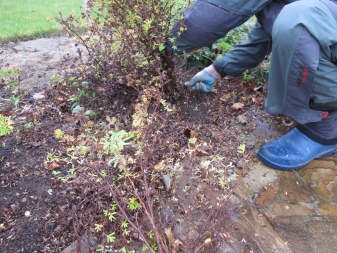
The most delicate varieties, for example "Joker", need shelter in winter. For these purposes, special bags made of "breathable" material are perfect.
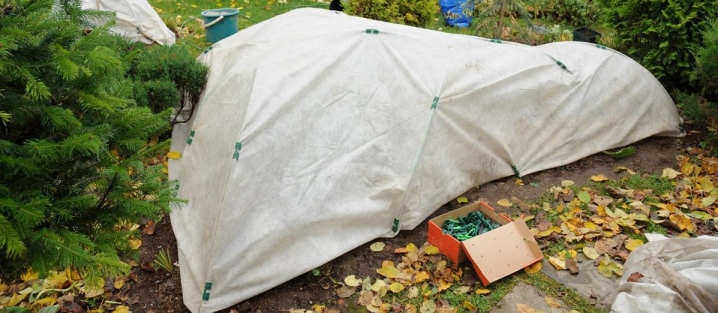
Diseases and pests infect red cinquefoil quite rarely. However, such an ailment as "rust" is still inherent in it. This disease manifests itself in the form of dark spots on the foliage of the plant, which over time dries up and falls off. In this case, the cinquefoil is treated with a special emulsion.
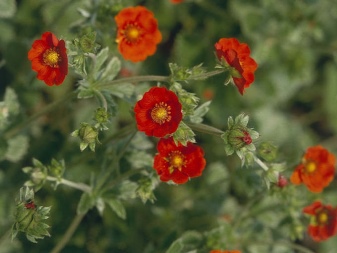
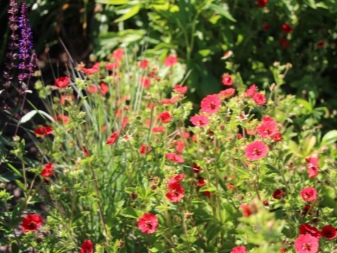
For even more important information about different varieties of red cinquefoil, see the video
Planting and caring for Red Ice Potentilla
The care and cultivation of Red Ace shrub cinquefoil does not require special skills and knowledge. Sun-loving culture is recommended to be planted in areas with sufficient lighting. A little shading will not affect the growth of Potentilla in any way. In addition, the Red Ice variety perfectly tolerates the wind, so no protective structures are required.
Recommended timing
It is recommended to plant a shrub plant in spring or autumn. It is during these periods that the root system of the culture can easily take root.
Spring planting should be carried out after the soil has completely warmed up. This will help the root system to form properly. As for the autumn landing, it is carried out a month before the onset of cold weather, around mid-September.
Attention! Young Red Ice Potentilla seedlings are planted in early autumn so that they can take root by the onset of winter.
It is preferable to plant the Red Ice variety in autumn or spring.
Site selection and soil preparation
Red Ice Cinquefoil requires a well-lit area for planting. It is desirable that in the summer, an openwork partial shade falls on the flower bed. Under the scorching rays of the sun, the flowers of Potentilla fade and lose their decorative effect.
Since the shrubs are not afraid of drafts, it is allowed to plant in open space. The most important thing is not to place it in soil that can retain moisture. To prevent the process of root decay, you should take care of drainage. In addition, the soil should have an acidity level in the pH range of 5.5-7.5.
Important! Planting a plant in loam is possible, but this will require mixing the soil with river sand in a 1: 1 ratio.
Landing algorithm
Before proceeding with the landing itself, a landing pit should be prepared 2 weeks before. This is done so that the soil has time to compact.
They dig a hole 50 cm deep. Drainage is laid out at the bottom of the planting hole, consisting of broken bricks, pebbles or rubble.If a group planting is planned, then the cinquefoil is planted in a trench. This method is relevant when creating a "hedge".
Planting Red Ice Potentilla is carried out according to the following algorithm:
- The soil dug out in the process of creating the hole is mixed with humus, foliage and fertilizers.
- A drainage layer is poured into the bottom of the hole.
- Then fill the hole exactly half with nutrient soil.
- The root system of the seedlings is carefully examined. Too long roots are shortened a little, and rotted parts are removed. The seedlings are placed in a pale pink solution of potassium permanganate for 50-60 minutes.
- After processing, the roots of the seedling are straightened and distributed in the hole. Then the hole is covered with soil and tamped a little. Shrubs are watered with warm water. Each well will require at least 10 liters of liquid.
- The last step is to mulch the trunk circle with peat.
Important! During the planting process, it is necessary to maintain the distance between the bushes. It must be at least 1 m.
Watering and feeding schedule
After planting is complete, young Red Ice specimens need regular watering. If the weather is dry outside, then the earth is moistened every 3 days. In other cases, it is permissible to water the plant once a week.
Adult specimens feed only on natural water. If there has been no precipitation for a long time, then the gardener can water the bushes on his own.
Kuril tea Red Ice in the first year of its life does well without fertilizers. Top dressing is carried out from the second year of the plant's life. In early spring (before flowering), the bushes are fertilized with compounds based on phosphorus and potassium.
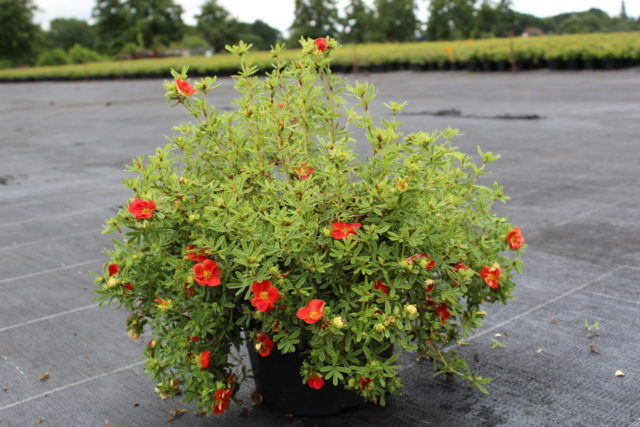
Cinquefoil is suitable for growing not only on the site, but also in pots and containers
Pruning
Shrub pruning is carried out in stages. First, sanitization is necessary, during which weak branches and shoots are removed. The procedure is carried out in the fall. Damaged and dried out shoots are removed in the spring.
Formative pruning is carried out every three years. To do this, the tops of the branches are shortened, giving the plant a decorative look.
How to prepare for winter
The culture of the Red Ice variety practically does not need preparation for wintering. Cinquefoil is a frost-resistant plant, therefore, in warm regions, the shrub is not even covered.
Before the onset of cold weather, the near-trunk space should be cleaned of foliage and other debris. If the climate of the region is harsh, then gardeners need to cover the plant with peat to a height of 15 cm, and then build a structure on which to wrap burlap. To protect the Red Ice cinquefoil from the harsh winter, the bushes can be covered with spruce branches.


